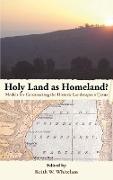Holy Land as Homeland? Models for Constructing the Historic Landscapes of Jesus
BücherAngebote / Angebote:
The quest for the historical Jesus has invariably tried to make senseof his world by constructing what it considers to be the historiclandscapes that he inhabited. These essays explore how we do notcreate an actual past or rediscover an actual landscape with its townsand villages but 'imaginary homelands' that allow us to inhabit andpossess the past.The papers in this volume explore the ways in which constructionsof the Holy Land as homeland have been mediated through historytextbooks, geographies and maps, and continue to exert an influenceon contemporary scholarship. The complex interrelationships betweenscholarship and its national settings is a constant thread throughoutthe papers: the work of many of the iconic figures of nineteenthandtwentieth-century European biblical scholarship (Moxnes), theroots of European constructions of homeland from the Enlightenmentonwards (Birch), American biblical scholarship in the twentieth century(Long), cartography and the construction of homeland (Whitelam), the constructions of a Galilaean homeland for Jesus (Baergen andVaage), a contemporary imagined homeland in British politics(Crossley). The final essay takes up the themes of 'home', 'homeland'and 'homelessness' to reflect on the methods and models that underpincontemporary scholarship (Penner and Lopez).These essays show how the scholarly task is a continuing questioning-and self-questioning-of the models and methods with which we aremost at home.The papers collected in this volume were presented in Oslo asone of the events organized by the 'Jesus in Cultural Complexity:Interpretation, Memory and Identification' project directed by HalvorMoxnes at the University of Oslo and funded by the NorwegianResearch Council.
Folgt in ca. 15 Arbeitstagen
